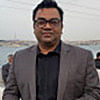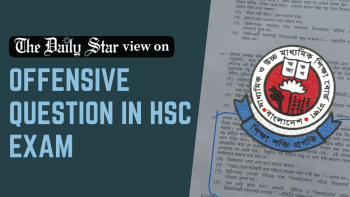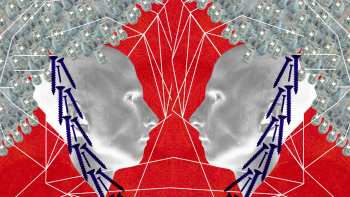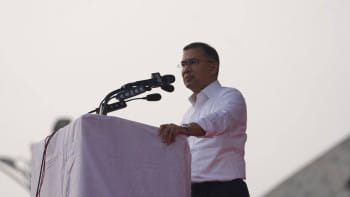Questioning the questions

There is a huge uproar over the questions that were set in this year's Higher Secondary Certificate (HSC) examinations. Ever since creative questions were adopted in board exams in 2008, there has been no short supply of confusion and controversies. Issues of incompetence, ignorance, insensitivity, indifference and/or immorality of those involved in setting and moderating creative questions have seasonally hit the press.
This year, a case-study application question set for Dhaka board's Bangla exam based on the play Sirajuddaula has been accused of carrying a communal undertone. The question mentions two Hindu brothers fighting over their property. To tease his brother Gopal, Nepal sells off one of his plots to a Muslim man, who observes cow sacrifice during Eid, prompting Nepal to leave the country for India. This is supposedly a case study to understand the role of Mir Jafar, who betrayed the last nawab of Bengal. The technical board carried another question that has been termed guilty of defaming a noted writer by name for his alleged hastiness in publishing rather clumsy books before every annual book fair. The case study was given to students to reflect on the pitfalls of pursuing fame by writers.
The phrasing of both these questions is insensitive. In the Bangla question, the moderator could have easily neutralised the question prompts without mentioning Hindu-Muslim-Cow-India. Similarly, the name of a real author should have been avoided.
The purpose of a creative question is to reduce the dependency on rote learning or memorising. The traditional testing method is notorious for restricting itself to a fixed number of essay questions, allowing students to procure prepared notes and reproduce them in exam halls with no learning retention. The change in the question format by the education ministry was, therefore, a welcome move.
But the lack of preparedness soon became evident. In May, an academic supervision report done by the Directorate of Secondary and Higher Education (DSHE) unpacked the problem by stating that only 45 percent of the teachers received three to six days of training on the "creative question setting." Still, 62 percent of teachers follow the implemented model to set these questions; 23 percent admitted to taking the help of colleagues to write questions, while 15 percent collected questions from other sources. In 14 years, we are yet to figure out how to ask, what to ask, and what not to ask.
Personally, I would love to see how the students responded to these two provocative issues in both critical and creative ways. We can protect our students from real-life religious tension and focus simply on betrayal, or we can give them real-life situations to see how they feel about the insensitivity shown to our neighbours. After all, life itself is an exam where we have to attempt many questions. The quality of the questions we face and solve directly influences our lives. For every situation in life, we can thus start by asking a simple question, "why," and then follow it up with a "how." We can then use this question trail to imagine a scenario to search for an answer.

Questions are now being asked about the "motives" of the question-setters. The Dhaka board spent no time blaming the Jashore board for getting them into trouble. I am surprised that they haven't blamed the lottery through which those questions were selected. Did they have an official parrot to pick up the envelopes containing the question papers? The teachers involved are already named and shamed and undergoing a media trial. If you ask me, by revealing the identity of the accused in an ongoing investigation, the officials are committing the same crime of being insensitive and intolerant, albeit communal.
Now that we know that the question-setter belongs to a minority sect, we need to ask: what did he want to say? Does his latent frustration wake us up to the insensitivity with which we conduct our animal sacrifices? Or does it confirm the stereotype that the minority prefers to leave this land as it does not cater to its belief system? Do we dare ask these questions? If not, is it okay to gag the question-setter? And if we grown-ups cannot ask or answer these questions, why put students in such a quagmire? More importantly, if we censor teachers from doing their jobs, how will they face their students in the classroom? More importantly, we constantly question the public assessment system, as is evident in the university admission tests. Universities don't trust the scores obtained in HSCs. They devise a new set of questions for the students to transition from the higher secondary to the tertiary.
We live in an intolerant time where everything is suspected. The cancel culture has not even left agriculture alone. When a group of scientists reported the presence of toxic elements in an agricultural product in an international journal, a group of toxic journalists attacked them for their supposed insensitivity to our national cause. The fangs were out to smite one of the researchers for publishing something "ridiculous," which backfired on them as their aggression merely proved their inadequacies and ignorance. The TV talk show exposed the professional rivalry that exists in our society. The all-knowing pseudo-omniscient journos have mastered the habit of quizzing experts or representatives from different professions with a fault-finding mission. They don't have the professional etiquette or expertise to ask creative and critical questions. Guess we need to question the way we approach our questions.
Dr Shamsad Mortuza is a professor of English at Dhaka University.

 For all latest news, follow The Daily Star's Google News channel.
For all latest news, follow The Daily Star's Google News channel. 










Comments